

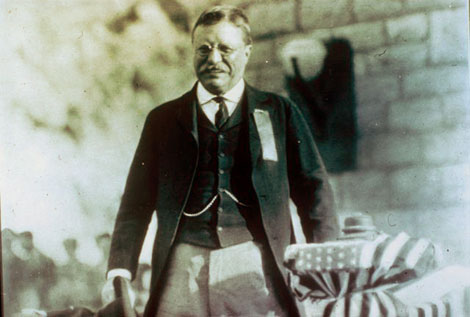 President Theodore Roosevelt at the dedication of Roosevelt Dam, March 18, 1911. (Reclamation photograph)
President Theodore Roosevelt at the dedication of Roosevelt Dam, March 18, 1911. (Reclamation photograph)"I want to recollect the men who built the dam, who made the road to the Roosevelt Dam from Phoenix." President Theodore ("Teddy") Roosevelt spoke these words during his March 18, 1911 dedication at the new dam named after him. It was indeed a diverse community of men, some with families, the President chose to acknowledge that day. One of the unique traits of the American West was just how quickly immigrants from around the world came together to create a new society. The people who hired on to build the dam reflect this trait. The dam builders included stonemasons from Italy, Scotland, Germany, and Switzerland who quarried and shaped the massive blocks for the dam. Laborers on the dam were a mix of Americans—Euro-American, African-American, Mexican-American, Asian-American, and American Indian—from nearly every state, and people from all parts of world. Some, like the Apache Indians, gained notoriety constructing the Apache Trail from Phoenix to the dam, the critical piece of infrastructure that allowed materials, supplies, and people to travel to the dam. Others, like the teamsters, many of whom were Mexicans, were critical to ensuring the success of the project, but received little notice for their contributions. Their heavy wagons moved material and supplies vital to the construction effort. This diverse workforce was overseen by a group of engineers from the fledging U.S. Reclamation Service working on one of the largest dam projects in the early 20th century.
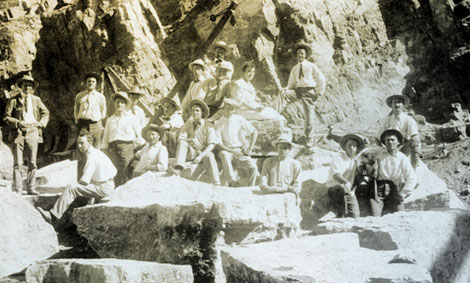 Roosevelt Dam was designed as a masonry dam that required each block of stone to be precisely cut and shaped. Stonemasons from around the world were sought out and hired for the demanding job. Masons of German, Scottish, Italian, and Swiss heritage worked on the dam. Here twenty-six Italian stonemasons from the East Coast pose for the Reclamation Service photographer Walter J. Lubken in 1906. (Reclamation photograph)
Roosevelt Dam was designed as a masonry dam that required each block of stone to be precisely cut and shaped. Stonemasons from around the world were sought out and hired for the demanding job. Masons of German, Scottish, Italian, and Swiss heritage worked on the dam. Here twenty-six Italian stonemasons from the East Coast pose for the Reclamation Service photographer Walter J. Lubken in 1906. (Reclamation photograph)
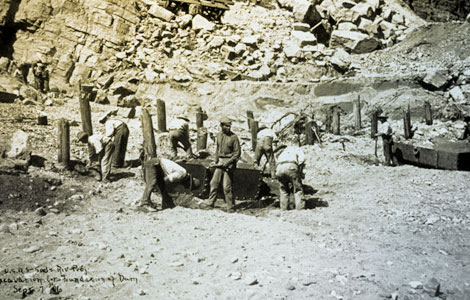 Workers from Arizona Territory—Black, Indian, Mexican, and Anglo—were joined by hundreds of other workers from numerous ethnic backgrounds from across the United States to work on Roosevelt Dam. Here they are pictured excavating the foundation for the dam, 1906. (Reclamation photograph)
Workers from Arizona Territory—Black, Indian, Mexican, and Anglo—were joined by hundreds of other workers from numerous ethnic backgrounds from across the United States to work on Roosevelt Dam. Here they are pictured excavating the foundation for the dam, 1906. (Reclamation photograph)
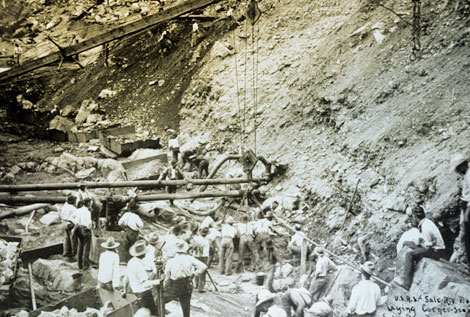 On September 20, 1906 workers ease the cornerstone of the dam into place. (Reclamation photograph)
On September 20, 1906 workers ease the cornerstone of the dam into place. (Reclamation photograph)
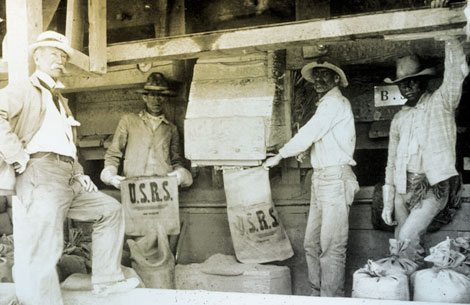 Because it was expensive to haul supplies from Mesa to the dam, the U.S. Reclamation Service built a cement plant on site, 1910. (Reclamation photograph)
Because it was expensive to haul supplies from Mesa to the dam, the U.S. Reclamation Service built a cement plant on site, 1910. (Reclamation photograph)
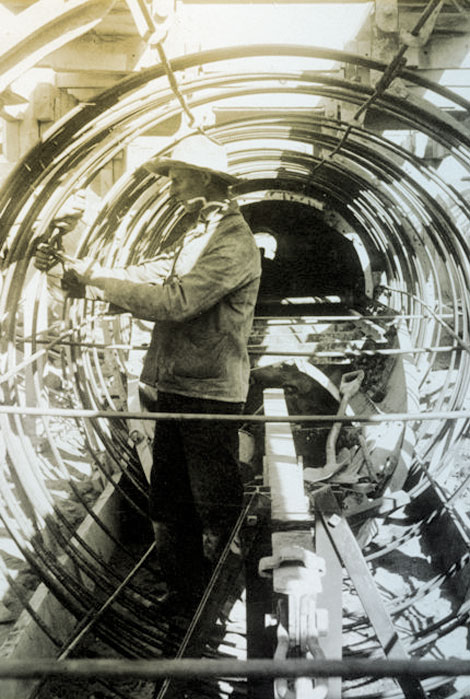 A hydropower plant provided electricity for the people building the dam and for running power equipment. Water for the generating units was brought via a diversion channel which crossed large drainages through a buried siphon. Here a workman is preparing the rebar frame for a siphon across Pinto Creek, 1905. (Reclamation photograph)
A hydropower plant provided electricity for the people building the dam and for running power equipment. Water for the generating units was brought via a diversion channel which crossed large drainages through a buried siphon. Here a workman is preparing the rebar frame for a siphon across Pinto Creek, 1905. (Reclamation photograph)
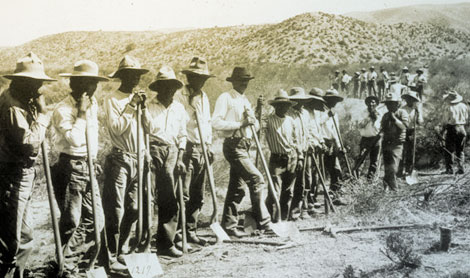 Apache workers built the road between Mesa and the dam site known as the Mesa–Roosevelt Road, 1907. By the 1920s it was called the “Apache Trail.” (Reclamation photograph)
Apache workers built the road between Mesa and the dam site known as the Mesa–Roosevelt Road, 1907. By the 1920s it was called the “Apache Trail.” (Reclamation photograph)
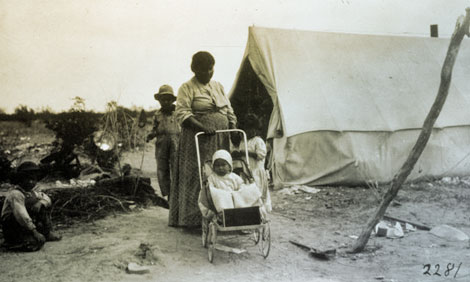 Like many Anglo workers, Apache families joined the men who worked on the dam. Apache families camped in segregated areas near the dam. (Reclamation photograph)
Like many Anglo workers, Apache families joined the men who worked on the dam. Apache families camped in segregated areas near the dam. (Reclamation photograph)
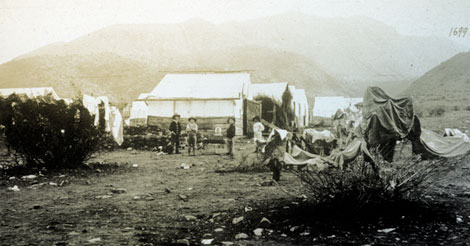 It's wash day in Roosevelt Town. Note the wood-framed tents used to house the workers' families, 1909. (Reclamation photograph)
It's wash day in Roosevelt Town. Note the wood-framed tents used to house the workers' families, 1909. (Reclamation photograph)
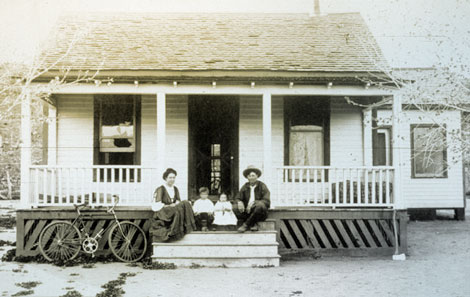 Luther Jackson and his family on the porch of their home, probably at Roosevelt. Luther was a ditch rider, most likely on the diversion canal that brought water to the generating plant. He was responsible for seeing that the canal worked as planned and was properly maintained, 1909. (Reclamation photograph)
Luther Jackson and his family on the porch of their home, probably at Roosevelt. Luther was a ditch rider, most likely on the diversion canal that brought water to the generating plant. He was responsible for seeing that the canal worked as planned and was properly maintained, 1909. (Reclamation photograph)
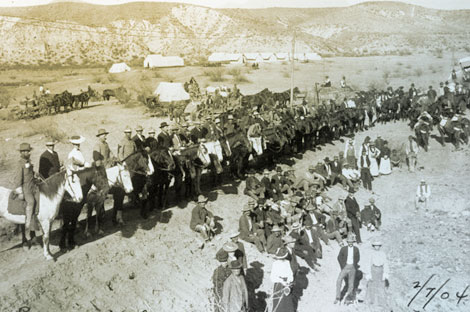 This 1904 photograph shows the dam builders assembled for a special event. The supervisors and engineers are on horseback, while workers and some of their wives sit or stand. (Reclamation photograph)
This 1904 photograph shows the dam builders assembled for a special event. The supervisors and engineers are on horseback, while workers and some of their wives sit or stand. (Reclamation photograph)